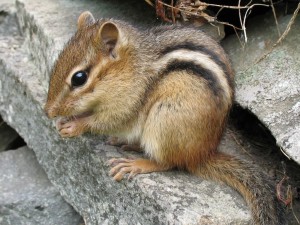Chipmunk
Chipmunk Photo credit: Gilles Gonthier https://www.flickr.com/photos/gillesgonthier/
Chipmunks (Tamias striatus) are small squirrel-like rodents native to North America. They reside in the far eastern portion of Kansas in oak-hickory woodlands as well as suburban neighborhoods. They have five dark stripes and two white stripes along their reddish-gray and brown bodies. There are also two dark stripes crossing the face, one at eye level and another stripe underneath the eye. Their birdlike chirping can alert others to the presence of threats.
The eastern chipmunk has internal cheek pouches used to carry food to their underground burrows. These pouches are also used to carry dirt away from the burrow during construction to avoid leaving evidence. Their burrows can be more than 30 feet long with multiple entrances. The chipmunk burrow has several chambers including clean sleeping quarters, a food cache chamber, and a refuse chamber.
Although chipmunks hibernate, there is no need to store fat since they can partake of the cache of nuts and seeds they have stored for the winter. Their diet consists of nuts, tree seeds (maple & oak in Kansas), berries, mushrooms, earthworms, slugs, grubs, insects, caterpillars, bird eggs, even frogs and salamanders. They also eat buds, shoots, and fungi including those involved in symbiotic relationships with trees such as truffles. The chipmunk plays an important role within the forest ecosystem by dispersing of seeds of trees, fruits and berries and the spores of fungi.
With only a 30-day gestation period resulting in a litter of two to eight, their numbers are kept in check by hawks, foxes, coyotes, weasels, and snakes.
The name “chipmunk” may be derived from the American Indian “Adjidaumo” pronounced a-chit’-a-mauk referring to their “head-first” descent of trees.

